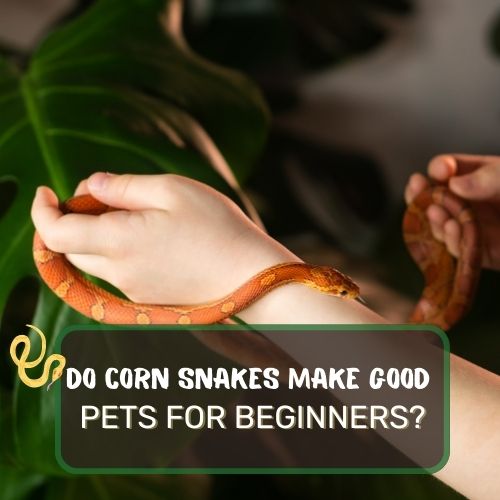
Are you pondering the question, “Do corn snakes make good pets for beginners?”
Well, you’re in for a treat!
This article delves deep into the world of corn snakes, exploring their behavior, care requirements, and the unique joys and challenges they bring.
We’ve sifted through essential factors like their temperament, dietary needs, and overall maintenance to give you a comprehensive answer.
By the end of this read, you’ll have a clear picture of whether these mesmerizing reptiles are the perfect fit for a newbie like you.
Dive in and discover the captivating world of corn snakes!
Table of Contents
- 1 Are Corn Snakes Beginner-friendly? (Short Answer)
- 2 Why Corn Snakes are considered as potential pets
- 3 Corn Snake Overview
- 4 Behavior and Temperament
- 5 Housing and Habitat
- 6 Diet and Feeding
- 7 Health and Well-being
- 8 Exercise and Enrichment
- 9 Cost and Upkeep
- 10 Pros and Cons of Keeping a Corn Snake
- 11 Purchasing or Adopting a Corn Snake
- 12 FAQ
- 13 Final Word
Are Corn Snakes Beginner-friendly? (Short Answer)
Absolutely! Corn snakes are often hailed as one of the best choices for beginner snake enthusiasts. Their docile nature makes handling a breeze, even for those new to reptiles. With straightforward care requirements, they don’t demand the intricate attention some other species might. Their moderate size ensures they’re manageable, and their captivating patterns offer a visual treat. Plus, they’re resilient, forgiving of the occasional newbie mistake. In short, if you’re venturing into the world of pet snakes, corn snakes are a fantastic, beginner-friendly option to consider.
Why Corn Snakes are considered as potential pets
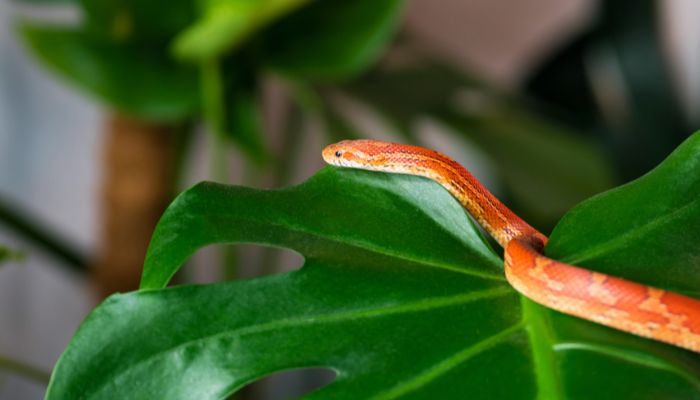
Ever wondered why corn snakes are often the talk of the town when it comes to beginner-friendly pets? Well, let’s dive into that.
Corn snakes, with their mesmerizing patterns and docile nature, have become a favorite in the reptile world, especially for beginners.
Their relatively easy care requirements combined with their gentle temperament make them an ideal choice for those just dipping their toes into the world of reptiles.
Imagine having a pet that not only looks stunning but is also forgiving of the occasional newbie mistake. That’s the corn snake for you!
Corn Snake Overview
Alright, let’s get to know our slithery friend a bit better, shall we?
Scientific name and common names
The corn snake, scientifically known as Pantherophis guttatus, has earned a variety of nicknames over the years. Some folks call them red rat snakes, while others might refer to them simply as rat snakes.
But no matter the name, this snake’s charm remains undeniable.
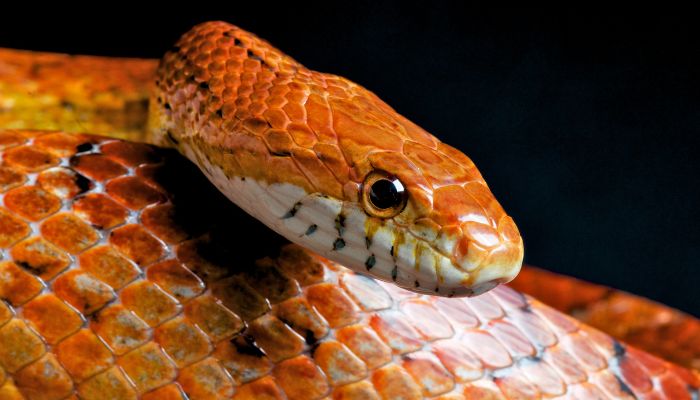
Lifespan in captivity vs. the wild
In the wild, life can be tough for corn snakes. With predators lurking around every corner and the constant search for food, a corn snake’s average lifespan in the wild is around 6-8 years. However, in captivity, it’s a different story.
With proper care, regular meals, and no natural predators to worry about, corn snakes can live up to 15-20 years! That’s a long commitment, but also a testament to how a loving home can extend the life of these beautiful creatures.
Typical size and appearance
Corn snakes are a visual treat! They typically grow to lengths of 3 to 5 feet, making them a medium-sized snake that’s not too intimidating for beginners.
Their appearance is characterized by vibrant patterns that can range from orange and brown to more exotic shades, depending on the specific morph.
These patterns are not just for show; they help the snake camouflage in the wild. In captivity, however, they’re a delightful display of nature’s artistry.
Behavior and Temperament
So, you’re thinking about bringing a corn snake into your life. But what can you expect from these slithering companions in terms of behavior?
Let’s unravel the mystery!
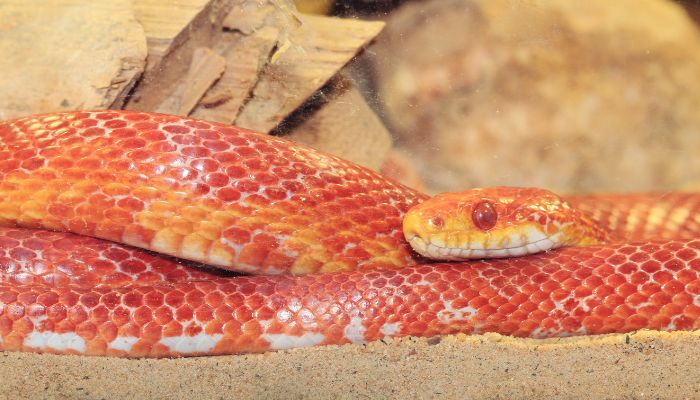
General behavior: activity levels, resting, exploring
Corn snakes are quite the explorers! During the day, they’re often on the move, slithering around, and investigating their surroundings.
But don’t be fooled; they also love their beauty sleep. It’s not uncommon to find them coiled up and resting, especially after a hearty meal.
Their curious nature means they might occasionally venture out of their hiding spots, giving you a delightful display of their exploring antics.
Interaction with humans: docility, handling, and potential for aggression
One of the reasons corn snakes are so popular among beginners is their generally docile nature. They’re typically easy-going and tolerate handling quite well, especially if introduced to it from a young age.
However, like all creatures, they have their limits. It’s essential to read their body language. If they seem stressed or agitated, it’s best to give them some space. While they’re not known for being aggressive, they might give a defensive nip if they feel threatened.
Unique behaviors: tail vibrating, climbing skills
Ever heard a corn snake “buzz”? When threatened or unsure, corn snakes might vibrate their tails. If they’re on a substrate like dry leaves, this can mimic the sound of a rattlesnake!
It’s their way of saying, “Back off!”
And let’s talk about their climbing prowess. Corn snakes are excellent climbers. Given the opportunity, they’ll ascend branches or even the sides of their enclosures, showcasing their arboreal skills.
Housing and Habitat
Alright, now that we’ve got a feel for their behavior let’s set up the perfect home for our corn snake pals.
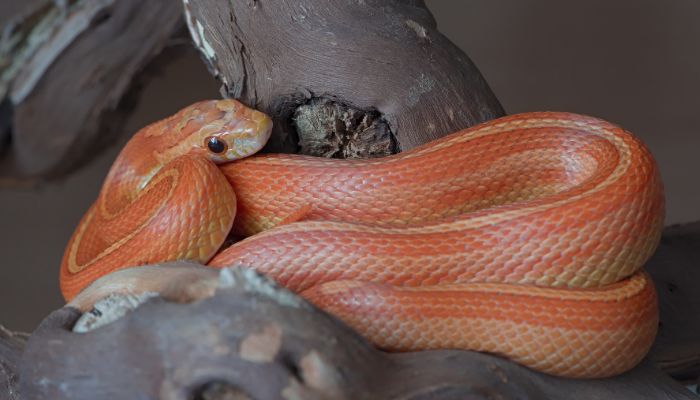
Ideal enclosure size and type
Size matters when it comes to your snake’s home. For an adult corn snake, an enclosure measuring around 20 gallons should suffice.
This provides ample space for them to move, explore, and stretch out. While glass terrariums are popular, plastic enclosures designed specifically for reptiles can offer better insulation and are easier to clean.
Importance of a secure lid and heat light
Corn snakes are escape artists! A secure lid is non-negotiable. You’d be surprised at the tiny gaps these sneaky snakes can squeeze through.
As for heating, corn snakes, like all reptiles, are ectothermic, meaning they rely on external sources for warmth.
A heat light or under-tank heater ensures they can regulate their body temperature, aiding in digestion and overall well-being.
Temperature requirements and establishing a thermal gradient
Maintaining the right temperature is crucial. Aim for a basking spot of around 85°F (29°C) and a cooler end in the mid-70s°F (around 24°C).
This thermal gradient allows your snake to choose the perfect spot, whether they’re in the mood to warm up or cool down.
Substrate needs and materials to avoid
For the floor of the enclosure, aspen shavings or newspaper are popular choices. They’re absorbent and easy to clean.
However, avoid cedar or pine shavings, as they can release oils harmful to snakes. Remember, the substrate isn’t just for looks; it’s also where your snake will spend most of its time, so comfort and safety are paramount.
Creating a comfortable, safe, and stimulating environment for your corn snake is key. With the right setup and understanding of their needs, you’re on your way to becoming a top-notch snake parent!
Diet and Feeding
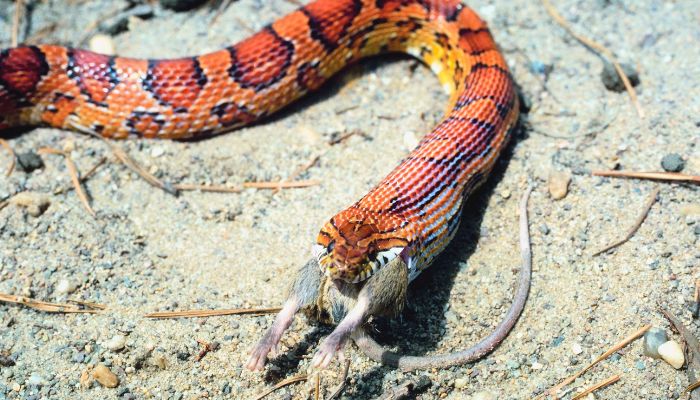
Feeding time! One of the most fascinating aspects of owning a snake is watching their unique feeding habits. But what exactly should you serve up on the menu for your corn snake?
What do corn snakes eat in the wild vs. captivity?
In the wild, corn snakes are opportunistic hunters, preying on a variety of critters like small rodents, birds, and even amphibians. However, in captivity, their diet becomes a tad more streamlined. The go-to meal? Rodents, particularly mice.
The benefits of a rodent-based diet
Rodents, especially mice, offer a balanced meal for corn snakes. They’re packed with essential nutrients, ensuring your snake gets everything it needs from protein to fats.
Plus, they’re relatively easy to source, making them a convenient choice for snake owners.
Feeding frequency and size of prey
Baby corn snakes have quite the appetite and will typically eat every 5-7 days. As they grow, this frequency decreases. Adult corn snakes usually dine once every 10-14 days.
As for the size? The prey should be roughly the same width as the snake’s mid-body. No more, no less.
The debate on live vs. frozen-thawed rodents
Ah, the age-old debate! While some argue that live prey stimulates the snake’s natural hunting instincts, others advocate for frozen-thawed rodents due to ethical and safety reasons.
Frozen prey eliminates the risk of the prey injuring the snake and is also more convenient for the owner. It’s essential to weigh the pros and cons and decide what’s best for your pet and your comfort level.
Health and Well-being
Just like any other pet, corn snakes need regular health check-ups and a keen eye to spot any potential issues.
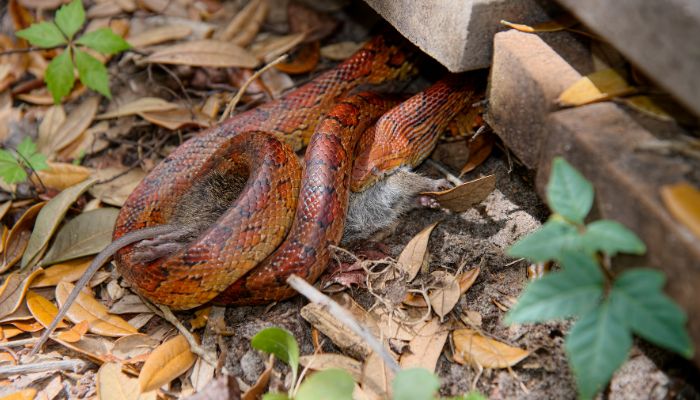
Common health problems: shedding issues, respiratory issues, parasites
Every snake owner dreads shedding issues. If a corn snake doesn’t shed its skin entirely, it can lead to infections. Respiratory issues, often signaled by wheezing or mucus, can be a sign of an unclean habitat or incorrect temperatures.
And then there are parasites – external ones like mites or internal ones affecting the digestive system.
Signs of a healthy vs. unhealthy corn snake
A healthy corn snake will have clear eyes (except during shedding), an active demeanor, and a strong appetite. On the flip side, an unhealthy snake might refuse food, show lethargy, or have visible skin issues.
Importance of regular vet check-ups
While corn snakes are relatively low-maintenance, regular vet visits are crucial. A reptile vet can spot potential issues early on, offer guidance on care, and ensure your slithery friend stays in tip-top shape.
While corn snakes are resilient creatures, they rely on their owners to provide the best care possible. From a balanced diet to regular health check-ups, every detail counts. Here’s to happy and healthy snake parenting!
Exercise and Enrichment
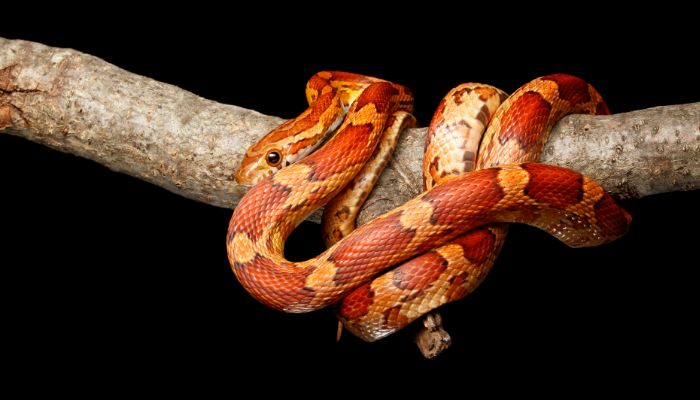
Let’s talk about fun and games! Just like any other pet, corn snakes need their fair share of playtime and stimulation. It’s not just about keeping them physically active but mentally sharp too.
Importance of mental and physical stimulation
A bored snake is an unhappy snake. Mental and physical stimulation not only keeps your corn snake entertained but also promotes natural behaviors and reduces stress. It’s essential for their overall well-being and happiness.
Ideas for enrichment: hiding food, climbing branches, different surfaces
Spice up your snake’s life with some enrichment activities! Try hiding their food, turning feeding time into a fun game of hide and seek. Introduce climbing branches in their enclosure, tapping into their natural climbing instincts.
And don’t forget about varying the surfaces. From smooth to rough, different textures can provide new and exciting experiences for your slithery friend.
Cost and Upkeep
Alright, let’s talk finances. Owning a corn snake, like any pet, comes with its set of expenses. But what can you expect to shell out for your new companion?
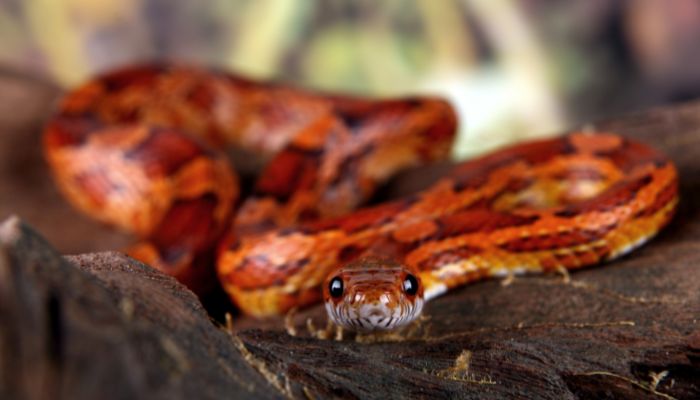
Initial investment: enclosure, accessories, lighting
Setting up your snake’s new home can be a bit of an investment. You’ll need an enclosure, which can vary in price depending on size and material. Then there are the accessories like hides, water dishes, and climbing branches.
And let’s not forget about lighting, essential for maintaining the right temperatures.
Monthly expenses: food, bedding, heat lights
Once you’re all set up, there are the monthly costs to consider. Food, typically rodents, will be a regular expense. Then there’s the bedding or substrate, which needs frequent changing.
And if you’re using heat lights, they might need replacing now and then.
Potential costs of vet care
While we hope our pets stay healthy forever, it’s always good to be prepared. Vet visits, especially if specialized for reptiles, can add up. It’s essential to factor in potential health care costs and maybe even consider pet insurance.
While corn snakes are relatively low-maintenance compared to some pets, they still require care, attention, and yes, a bit of an investment. But with their captivating charm and gentle nature, they’re worth every penny!
Pros and Cons of Keeping a Corn Snake

Every pet comes with its set of joys and challenges, and corn snakes are no exception. Let’s weigh the pros and cons of having one of these mesmerizing creatures as a companion.
Benefits: docility, ease of care, lifespan, variety in appearance
Docility: One of the standout traits of corn snakes is their gentle nature. They’re typically non-aggressive, making them a joy to handle and interact with.
Ease of Care: For a reptile, corn snakes have relatively straightforward care requirements. No complicated diets or intricate habitats needed!
Lifespan: With proper care, these snakes can be your companion for up to 15-20 years. That’s a lot of quality snake time!
Variety in Appearance: From vibrant oranges to muted browns, corn snakes come in a plethora of patterns and colors, ensuring you’ll find one that captivates you.
Challenges: feeding requirements, potential lifespan commitment
Feeding Requirements: While their diet isn’t complicated, feeding a snake can be a unique experience, especially if you’re squeamish about rodents.
Potential Lifespan Commitment: A pet that can live up to two decades is a significant commitment. It’s essential to be prepared for the long haul.
Purchasing or Adopting a Corn Snake
So, you’re sold on getting a corn snake. But where do you start your search?

Where to buy: pet stores, reptile shows, breeders
Pet Stores: Many pet stores carry corn snakes, especially those specializing in reptiles.
Reptile Shows: These events are a haven for reptile enthusiasts. You’ll not only find corn snakes but also get a chance to interact with breeders and other owners.
Breeders: Purchasing directly from a breeder can be a great way to ensure you’re getting a healthy snake. Plus, they can provide invaluable insights into care and handling.
Costs associated with different morphs and ages
Corn snakes come in various morphs, each with its unique appearance and, consequently, price tag. Rarer morphs can fetch higher prices. Similarly, age can influence cost, with baby snakes typically being more affordable than mature ones.
Importance of ethical sourcing
Lastly, but most importantly, always prioritize ethical sourcing. Ensure that the snake hasn’t been wild-caught or subjected to poor living conditions. Ethical sourcing not only ensures you get a healthy pet but also promotes responsible pet trade practices.
In conclusion, while there’s a lot to consider when getting a corn snake, the joy they bring makes it all worthwhile. Here’s to a future filled with slithery cuddles and mesmerizing patterns!
FAQ
Ah, the burning questions! When it comes to corn snakes, there’s a lot of curiosity out there. Let’s tackle some of the most frequently asked questions about these fascinating reptiles.
Do corn snakes like to be held?
Corn snakes are among the more tolerant reptiles when it comes to handling. While they don’t “like” being held in the same way a dog might enjoy a belly rub, they’re generally docile and can become accustomed to regular handling. It’s essential, however, to handle them gently and avoid sudden movements. Over time, with consistent and gentle interactions, your corn snake can become quite comfortable in your hands.
What is the easiest snake to keep as a pet?
While there are many beginner-friendly snakes out there, corn snakes often top the list. Their manageable size, docile nature, and straightforward care requirements make them a favorite among first-time snake owners. Other contenders for the title might include ball pythons and king snakes, but corn snakes are often hailed as the gold standard for newbie snake enthusiasts.
How big do corn snakes get?
Corn snakes are medium-sized reptiles. On average, they grow to lengths of 3 to 5 feet. However, some individuals, especially males, can reach lengths of up to 6 feet. It’s a good size – not too small that they’re delicate, but not so large that they become unmanageable.
What do corn snakes eat?
In the wild, corn snakes have a varied diet, including small rodents, birds, and amphibians. In captivity, their diet is more streamlined. The primary food source for captive corn snakes? Rodents, particularly mice. These provide all the essential nutrients a corn snake needs to thrive.
Do corn snakes bite?
Any animal with a mouth can bite, and corn snakes are no exception. However, they’re not known for being aggressive. Most bites occur due to mistaken identity (thinking a hand is food) or if the snake feels threatened. It’s worth noting that a corn snake’s bite, while surprising, is not dangerous and is more of a pinch.
Final Word
Well, look at you, making it to the tail end of our scaly saga!
You’ve journeyed through the corn snake cosmos, from their star-studded appearances to their not-so-demanding backstage requests.
We’ve dished out the deets on their temperament (spoiler: they’re not the divas of the reptile world) and even gave you a sneak peek into their dietary green room demands.
It’s been quite the ride, hasn’t it?
But here’s the golden nugget: while they might not be penning autographs or starring in the next big reptile blockbuster, corn snakes have a certain je ne sais quoi that’s hard to resist.
They’re the unsung heroes of the beginner reptile realm, waiting for their moment in the spotlight of your home.
So, if you’re teetering on the edge of snake parenthood, remember this: every legendary snake charmer started with a single, scaly step.
Why not let a corn snake be your dance partner? Go on, embrace the slither and slide into this exciting world.
After all, with a corn snake by your side, you’re bound to have some hiss-terical adventures!

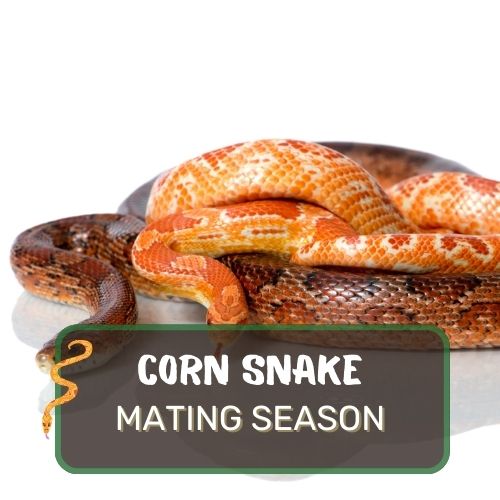
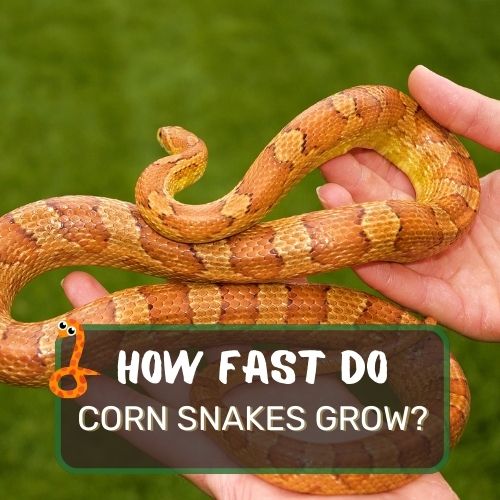
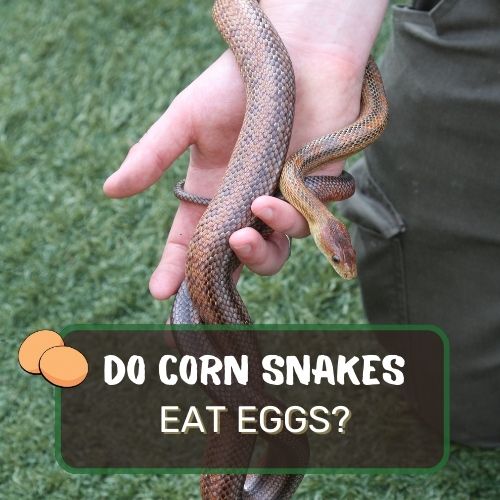
0 Comments